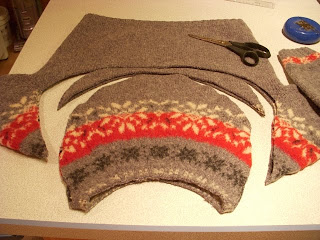I found this slightly-felted Eddie Bauer sweater at my local Salvation Army store. It's 85% wool and 15% nylon. Nice and thick, and only $4.75. I think I can make something new out of this...

Son likes gray for his winter outerwear this year, so I thought he'd appreciate a refashion from this sweater until I can get around to knitting him something special. After consulting him and giving it some thought, I think I can get a complete set of hat, scarf and mittens from this one sweater. He said he'd like the hat first.
I threw this sweater (along with some others I bought at Salvation Army), into a washer load of towels, washed it in hot water and then threw it in the dryer so that it could felt up even further than it was when I bought it. It originally measured 23" long and 20" wide, and shrank down to 21" long and 18" wide. It got thicker and sturdier, especially where the red band has extra yarn in the fabric.
That red band with the snowflakes on it was just too pretty to waste, so I decided to make the hat in such a way as to preserve it. I've seen lots of refashions where hats were made from sleeves or from bottoms of sweaters, but I haven't seen one yet where the hat was made from the neckline. So I'm going out a little on a limb here and we'll see where it leads me. First, I had Son try on the sweater upside down, as if the neck ribbing were hat ribbing, to see if I could keep that ribbing on. Nope. Too small by about an inch, so I cut it off, leaving as much fabric at the neckline as I could, just in case I needed it. I can trim it off later if I want to, since the felted fabric won't unravel.

I measured Son's head from front to back, and from the bottom of his ear to the top of his head. Using those measurements as a starting point, I cut out an oversized semi-circle from the sweater (making sure to line up the pattern on both layers), cutting through the front and back at the same time. I now have two pieces of sweater. I got carried away and cut waaaay too big a semi-circle, so I trimmed it a bit. Son and Husband are both, shall we say, cranially endowed. I had to leave enough fabric so that I could cut some off if need be, rather than wish I had more.
I pinned the layers together, wrong sides facing, and making sure that the pattern was lined up.
Then I had Son test-fit it. Basted it together, had him test-fit it again, and basted it again until I had it just the way he wanted it. During this time we discovered that not only was this going to be a really warm wool hat, but it would cover his ears, too! Brownie points to me for deciding to use the neckline, huh?
This is what it looks like finally sewn together. I also sewed a small seam going from front to back at the crown of the hat, to help it conform to Son's head.
All that remains is to blanket stitch the border of the hat to make it look more finished. While I was doing that, Son and Husband went out to chop wood for the stove. I looked out the window and noticed that Son was bare-headed. Can't have that. So I took him the hat as it was, and he wore it for the first time before it was even complete.
Here's an action shot. By the way, I made Husband's hat, too. His is a wool-blend double-knit that took me something like three weeks to finish!
And here's what the hat looks like with the blanket stitching and the flap ties. Not that Son ever intends to actually tie the flaps down, so they're short and purely decorative.
Here's Son on our balcony, overlooking our snowy lake, holding his puppy and wondering when I'm going to get around to making the rest of his refashion outfit!

















